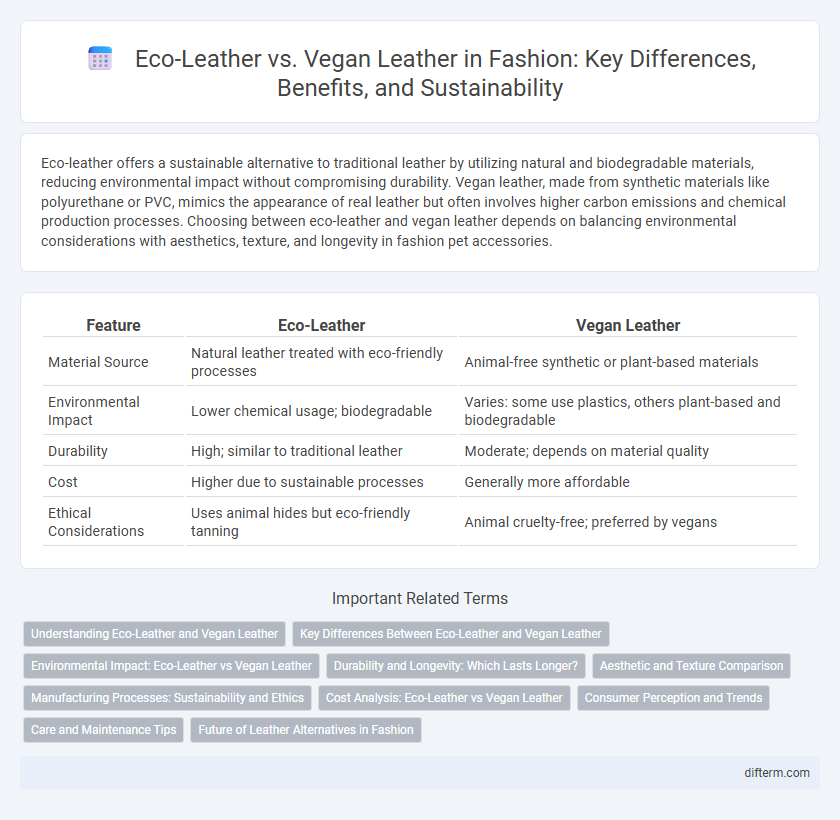Eco-leather offers a sustainable alternative to traditional leather by utilizing natural and biodegradable materials, reducing environmental impact without compromising durability. Vegan leather, made from synthetic materials like polyurethane or PVC, mimics the appearance of real leather but often involves higher carbon emissions and chemical production processes. Choosing between eco-leather and vegan leather depends on balancing environmental considerations with aesthetics, texture, and longevity in fashion pet accessories.
Table of Comparison
| Feature | Eco-Leather | Vegan Leather |
|---|---|---|
| Material Source | Natural leather treated with eco-friendly processes | Animal-free synthetic or plant-based materials |
| Environmental Impact | Lower chemical usage; biodegradable | Varies: some use plastics, others plant-based and biodegradable |
| Durability | High; similar to traditional leather | Moderate; depends on material quality |
| Cost | Higher due to sustainable processes | Generally more affordable |
| Ethical Considerations | Uses animal hides but eco-friendly tanning | Animal cruelty-free; preferred by vegans |
Understanding Eco-Leather and Vegan Leather
Eco-leather is crafted by enhancing genuine animal leather with environmentally friendly treatments to reduce harmful chemicals and extend durability, blending sustainability with traditional leather qualities. Vegan leather, made from synthetic or plant-based materials such as polyurethane or pineapple leaves, offers a cruelty-free alternative designed to mimic the appearance and texture of real leather without animal involvement. Both materials serve as eco-conscious choices in fashion, appealing to different ethical and environmental priorities while transforming the leather industry's impact.
Key Differences Between Eco-Leather and Vegan Leather
Eco-leather is crafted from natural animal hides treated with environmentally friendly processes to minimize chemical use and reduce environmental impact, whereas vegan leather is made from synthetic materials like polyurethane or natural plant-based alternatives such as pineapple leaves or cork. The durability of eco-leather often surpasses that of vegan leather, offering a more breathable and long-lasting option, while vegan leather provides a cruelty-free choice with a wider range of textures and colors. Biodegradability and production carbon footprint are significant differentiators, with eco-leather generally breaking down more naturally but requiring animal resources, unlike vegan leather, which avoids animal products but may involve plastics with higher environmental costs.
Environmental Impact: Eco-Leather vs Vegan Leather
Eco-leather, made from treated natural hides, generally involves lower synthetic chemical use compared to vegan leather, which relies heavily on plastics like polyurethane or PVC. Vegan leather production tends to contribute more to microplastic pollution and fossil fuel consumption, increasing its environmental footprint. Sustainable eco-leather options aim to balance durability and biodegradability, offering a more eco-conscious alternative in fashion materials.
Durability and Longevity: Which Lasts Longer?
Eco-leather, crafted from natural or recycled materials with minimal chemical processing, generally offers superior durability and breathability compared to synthetic vegan leather. Vegan leather, often made from polyurethane or PVC, can be less resistant to wear and prone to cracking over time, impacting its longevity. Choosing eco-leather supports both environmental sustainability and a longer-lasting fashion investment due to its robust material properties.
Aesthetic and Texture Comparison
Eco-leather offers a natural grain pattern and a supple texture closely resembling traditional leather, providing a luxurious and durable feel. Vegan leather, often made from synthetic materials like polyurethane or plant-based alternatives, varies widely in texture but can deliver smooth or textured finishes designed to mimic animal leather's aesthetic appeal. While eco-leather emphasizes biodegradability and breathability, vegan leather excels in versatility and water resistance, influencing the tactile and visual experience in fashion applications.
Manufacturing Processes: Sustainability and Ethics
Eco-leather is produced using natural tanning agents and sustainable raw materials that minimize environmental impact, while vegan leather is typically made from synthetic or plant-based materials designed to reduce animal harm and resource consumption. Manufacturing eco-leather often involves fewer toxic chemicals compared to traditional leather processing, promoting ethical labor practices and water conservation. Vegan leather's sustainability depends on the base material, with advanced options like mushroom or pineapple fibers offering biodegradable alternatives to plastic-based variants.
Cost Analysis: Eco-Leather vs Vegan Leather
Eco-leather typically costs more than vegan leather due to its production process that uses natural materials and sustainable tanning methods, resulting in higher wear resistance and durability. Vegan leather, often made from synthetic materials like polyurethane or PVC, is generally more affordable but may have a shorter lifespan and environmental concerns related to plastic use. Brands focusing on eco-friendly fashion weigh these cost differences against consumer demand for sustainability and product longevity.
Consumer Perception and Trends
Consumer perception increasingly favors eco-leather for its natural origin and durability, contrasting with vegan leather, often seen as synthetic and less environmentally friendly. Trends indicate a growing market demand for transparent sourcing and sustainable production practices in both materials. Brands emphasizing eco-leather's biodegradability and vegan leather's innovative plant-based alternatives attract eco-conscious buyers seeking style without compromise.
Care and Maintenance Tips
Eco-leather requires gentle cleaning with a damp cloth and occasional conditioning with plant-based oils to maintain its natural texture and prevent cracking. Vegan leather, typically made from synthetic materials like polyurethane or PVC, should be cleaned using mild soap and water to avoid damaging the surface and causing peeling. Both types benefit from avoiding direct sunlight and heat to prolong durability and preserve their appearance.
Future of Leather Alternatives in Fashion
Eco-leather, derived from treated natural leather with reduced environmental impact, contrasts with vegan leather made from synthetic or plant-based materials designed to eliminate animal use. Innovations in biofabrication and sustainable sourcing drive the future of leather alternatives, offering durability, lower carbon footprints, and biodegradability. Growing consumer demand and regulatory pressure push fashion brands to adopt these eco-conscious materials, transforming the industry towards circular and cruelty-free practices.
eco-leather vs vegan leather Infographic

 difterm.com
difterm.com